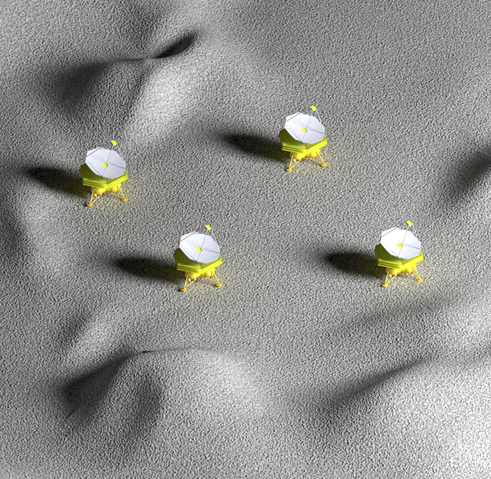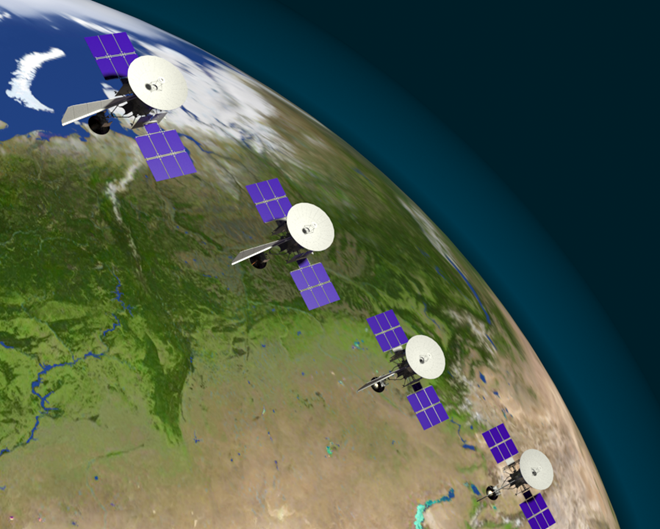Scientists from the Astro Space Center of the P. N. Lebedev Physical Institute of the Russian Academy of Sciences are developing several concepts of sub-terahertz (frequency from 100 GHz and above) observatories of the next generation. Among them, it is planned to create a compact ground antenna array, a pure space interferometer, and a telescope located on the Moon's surface. Ground-based antenna array will be able to work with other ground telescopes, as well as with the Millimetron space observatory in the very long baseline interferometer mode. More information about the upcoming observatories can be found in the journal Cosmic Research.
The last decade has been marked by significant advances in the study of the Universe in the sub-terahertz, that is, in the millimeter and submillimeter spectral range (frequency from 100 to several 1000 GHz). This was largely due to the successes of the Herschel and James Webb Telescope space missions. However, ground-based projects such as the IRAM telescope, the NOEMA interferometer and the ALMA antenna array have also succeeded. An significant result of ground-based observations was the acquisition by the Event Horizon Telescope (EHT) of images of supermassive black holes at the center of our Galaxy and in the M87 galaxy.
Observations in the sub-terahertz range touch the most pressing issues of modern astrophysics. This is the evolution of the early Universe, stars and planets formation processes, the search and study for complex organic compounds in the interstellar medium and young stellar systems, and the study of compact supermassive objects. The fact is that the interstellar medium is more transparent at sub-terahertz frequencies than radio or infrared ranges. This provides an unprecedented opportunity to directly observe supermassive black holes in active galactic nuclei and study matter behavior in such extreme conditions. Another unresolved issue is the formation of the “building blocks” from which the first replicator molecules were formed on our planet. There is an assumption that they appeared at the stage of planet and star formation. Moreover, in quantities sufficient for detection by future observatories. A separate task is to study the early Universe and search for distortions in the spectrum of cosmic microwave background radiation.
In the near future, it is planned to create new observatories operating at sub-terahertz frequencies. The existing ground VLBI network will be extended, and new instruments will be added to it. However, at high frequencies, ground observatories are significantly limited by the Earth's atmosphere. Another problem is that there are no sub-terahertz observatories in large areas of northeastern Eurasia. This white spot on the ground VLBI network map negatively affects observation quality. Various concepts for space observatories and interferometers are also being developed. For example, SMVA (Space Millimeter VLBI Array), EHI (Event Horizon Imager), THEZA (TeraHertz Exploration and Zooming-in for Astrophysics) and CAPELLA. But full-fledged observations in the sub-terahertz range are possible only with the development of both ground and space observatories.
Today in the Russian Federation there are practically no telescopes capable of observations at frequencies above 100 GHz. In turn, the Astro Space Center (ASC LPI) actively developing the “Millimetron” (Spektr-M) space observatory. In recent work, ASC LPI specialists examined several concepts of sub-terahertz observatories. These included projects for a sub-terahertz ground-based antenna array (a compact array), a space interferometer and a telescope located on the Moon's surface.
Ground Antenna Array
The array prototype will consist of several antennas (between 3 and 6 antennas) with a diameter of three to five meters. Initially, it will be installed at the Pushchino Radio Astronomy Observatory (PRAO) for testing purposes. After completing the tests, scientists plan to create a full-fledged sub-terahertz observatory based on the developed prototypes. It will consist of six fully rotating antennas with a diameter of up to 8 meters and a surface quality of the antennas of about 40 microns. Moreover, it will be possible to begin observations with three antennas. The angular resolution of the resulting instrument will reach 0.59'' arcseconds. It is planned to place the antenna array either on a local plateau on Mount Mayak in Dagestan (height above sea level 2352 m) or on the Khulugaisha peak in the Sayans (height above sea level 3015 m).

Observatory on the Moon
From a scientific point of view, lunar telescopes operating at frequencies inaccessible on the Earth’s surface will be extremely promising. These are two main types of frequencies: low frequency ranges (frequency below 10 MHz, meter waves) and high frequency ranges (>100 GHz, including far infrared). In the first case, observations from the Earth are restricted by the ionosphere and man-made radio noise; in the second, restrictions are associated with absorption and fluctuations caused by the atmosphere. These problems do not exist on the Moon's surface. Scientific tasks in the high-frequency range are high priority. The ASC LPI is developing several options for a radio interferometric antenna array, depending on the observatory location on the Moon.
The first option involves placing the entire antenna array system inside a dark crater. This would reduce the load on scientific instruments' cryo-systems, but complicate their energy supply. A solution to this problem could be a special service module that lands in an area illuminated by the Sun. In addition to generating and transmitting electricity for antenna modules in the crater, it could exchange scientific and service data between the observatory and the Earth (possibly through a lunar orbital relay).
Another option is the construction of an antenna array in the subpolar zone in an area illuminated by the Sun. This removes the problem of antenna power supply and makes them more autonomous. Moreover, individual elements of the antenna array can be stationary or mobile. Antennas moving along the surface could arrange an optimal location for observations on the lunar surface. True, this may create technical difficulties due to large device dimensions.
The lunar antenna array, working in conjunction with a ground telescope network, will make it possible to “see” the shadows of black holes with a resolution up to 30 times better than the Event Horizon Telescope did. This will lead to a breakthrough in the study of the physics of supermassive black holes. The lunar observatory will also explore the early Universe through observations of spectral distortions of cosmic microwave background radiation. It will also study some star formation problems.

Space Interferometer
The third promising direction, which can use the experience of a universal antenna array, is a space interferometer (space-to-space interferometer or pure space interferometer). The ASC LPI acquired vast experience in this area during the development of the Radioastron and Millimetron space observatories. Therefore, the new space interferometer can have baseline projections of up to 1.5 million kilometers or more. This will make it possible to achieve the extremely high angular resolution necessary for studying ultra-compact astronomical objects, such as black holes, extragalactic maser sources and neutron stars. The space interferometer, in contrast to the antenna array located on the Moon's surface, will be able to observe the close vicinity of supermassive black holes in dynamics. This will make it possible to observe matter movement under extreme conditions in the immediate vicinity of the event horizon. Such observations are feasible in the so-called “snapshot” mode, when the optimal orbital configuration of space telescopes makes it possible to restore a relatively high-quality image of the source in the shortest time. The most suitable and closest objects for such studies are Sgr A* or M87.

Back